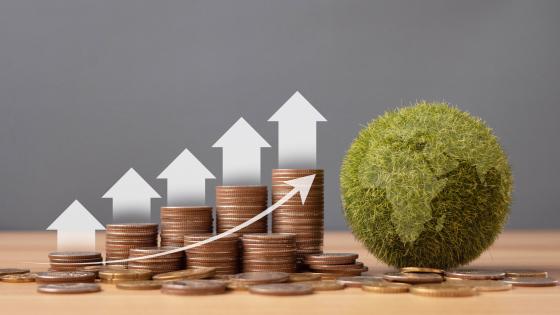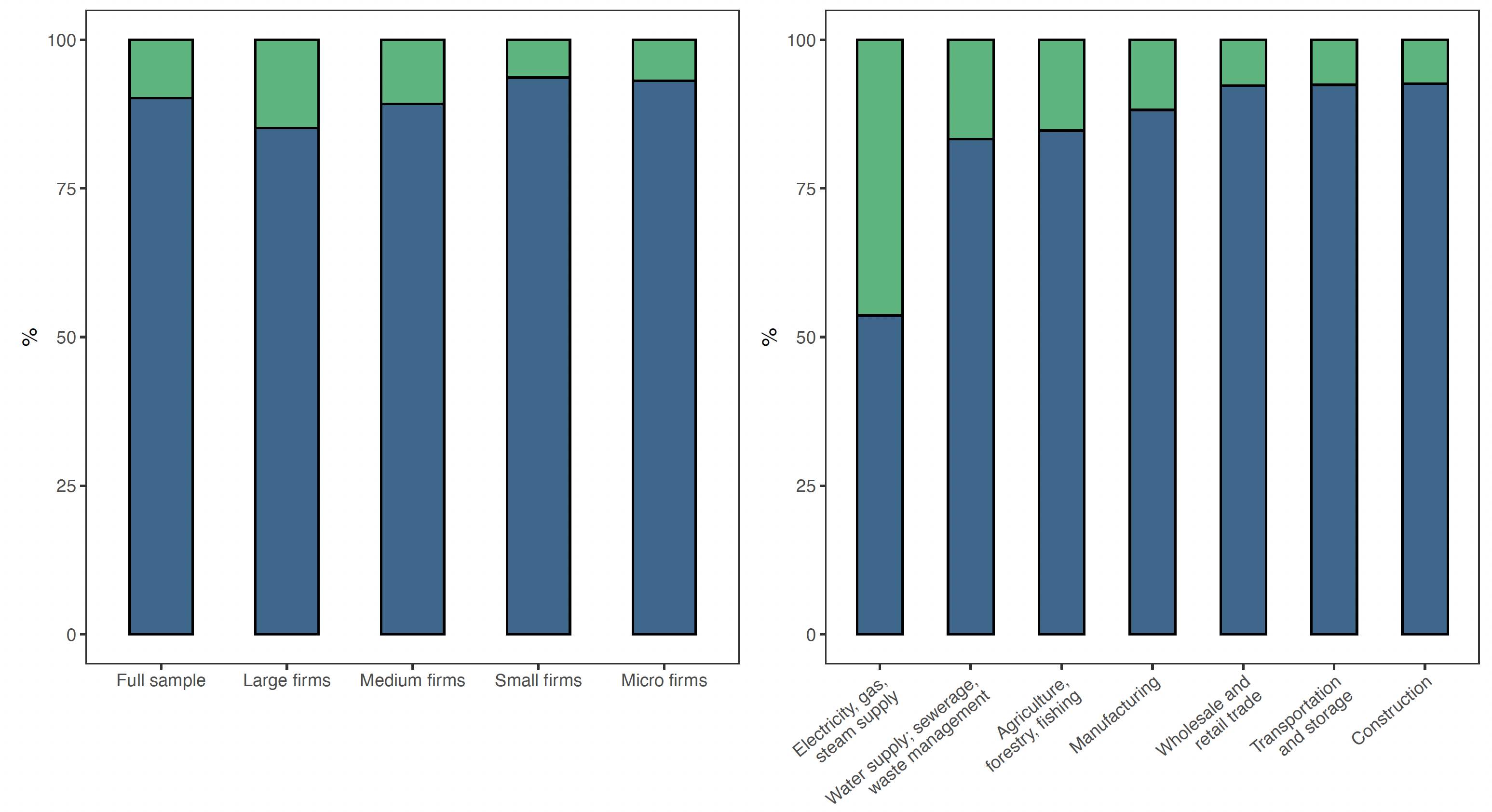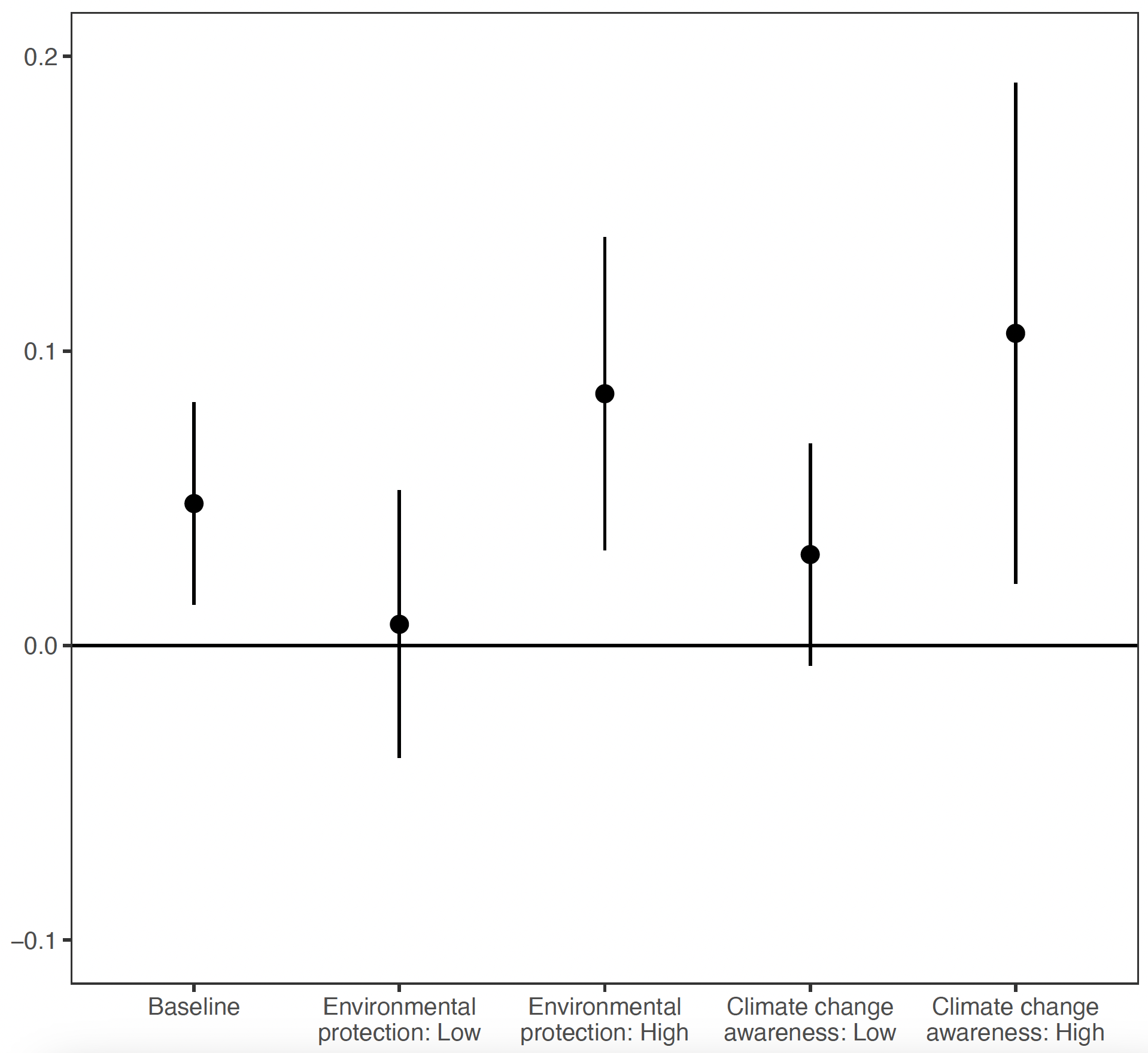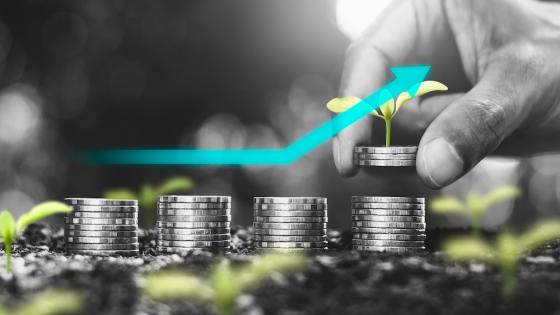According to the Intergovernmental Panel on Climate Change’s latest report, any hope of limiting global temperature rise to 1.5C would mean halving global emissions by 2030 and reaching net zero by 2050. To achieve these goals, investing heavily in renewable and other ‘green’ technologies that can replace carbon-intensive ones will be imperative. However, progress toward the green transition could be slowed by credit constraints, as reported by the Investment Survey carried out by the European Investment Bank, an issue that was recently underlined also by Degryse et al. (2022) and Borio et al. (2022).
Deep literature has shown that credit supply directly affects investments in capital expenditures (Peek and Rosengren 2000, Campello et al. 2010, Duchin et al. 2010, Lemmon and Roberts 2010, Cingano et al. 2016, Amiti and Weinstein 2018). These results may not straightforwardly extend to green investments, however. Recent theory suggests that irrespective of credit availability, firms may not have the incentive to invest in green technologies without government intervention, such as carbon taxes or research subsidies (Acemoglu et al. 2012, Acemoglu et al. 2016). On the other hand, other evidence suggests that investors are increasingly internalising externalities and incorporating environmental and social preferences in their investment decisions (Benabou and Tirole 2006, Hart and Zingales 2017, Oehmke and Opp 2020, Pastor et al. 2021) and that institutional investors derive value from pro-social investments (Krueger et al. 2020, Ceccarelli et al. 2021). If managers and entrepreneurs also internalise these externalities, then they might respond to an increase in credit supply by investing more in green technologies, even in the absence of government intervention.
Our study
In a recent study (Accetturo et al. 2022), we ask whether an increase in credit availability affects firms’ propensity to invest in green technologies. To answer this question, we use the information on approximately 30,000 Italian firms from 2015 to 2019. We start with detailed loan-level data from the Italian Credit Register to identify the amount of credit supplied to each firm - purged of demand-side effects using an instrumental variables approach. We then relate this to the likelihood of each firm investing in green technology, which we determine based on the financial statements.
Measuring investment greenness using firms’ actual investments
Our approach to identifying green investments is novel in this context because we rely on the actual investments undertaken by firms – as disclosed in the text comments accompanying their financial statements. We first construct a ‘dictionary’ of green words drawing on several sources (including the EU taxonomy for environmentally sustainable activities, green keywords identified by Sautner et al. (2020), and mandatory sustainability reports filed by Italian public firms). We then apply text algorithms on the comments to the investments section of firms’ financial statements. The firm is classified as engaging in green investments if the financial statements contain any identified keywords. One benefit of this approach is that we do not need to rely on self-reported measures of greenness, which could be more vulnerable to greenwashing.
One in ten firms made green investments
We find that 9.8% of firms made at least one green investment between 2015 and 2019. There was little variation in the number of firms making such investments year-to-year (approximately 6%); medium and large firms (as compared to micro and small firms) were more likely to undertake them (Figure 1, left panel). We also find differences across sectors. As expected, the largest fraction of firms investing in green technology are in the electricity, gas, and steam supply sector, followed by water supply and waste management (Figure 1, right panel).
Figure 1 Distribution of ‘green’ firms across sizes and sectors
Source: Authors’ calculations on Cerved data.
Notes: Share of firms that undertook green investments at least once over 2015-19.
Green investments increase with credit supply
Our specification relates the probability a firm invests in green technologies to the amount of available credit. In order to cope with usual endogeneity problems, we use an instrumental variable approach. Our instrument is based on the amount of credit supplied to each firm and is calculated as the weighted average of bank-specific credit supply shocks. These shocks are estimated from nationwide information on all credit disbursed in Italy, purged of local, industry, and time-varying demand factors.
We find that a one standard deviation increase in credit supply raises the likelihood of firms investing in green technology by between 1.9 and 3.4 percentage points (around 15% of its standard deviation). In contrast, a similar analysis on general investments did not yield any significant results. This finding is consistent with empirical evidence showing that bank credit affects the external margin of investments only in recessionary periods; when the economy is growing (like it was in Italy from 2015 to 2019), possible shortages in the bank credit market can be compensated by internal sources of funds or trade credit (Gaiotti 2013).
Green investments absorb larger financial resources
Diving deeper into our main result, we find that the high elasticity of green investments to credit supply is driven by more profitable, more liquid, more solvent, larger and older firms – that is, firms with more financial resources. This suggests that relative to other types of investments, green investments require more financial resources that must be matched by internal funds. The high capital intensity of green investments could explain why they are particularly responsive to credit supply.
Environmental preferences drive green investments
The propensity to invest in green technologies crucially depends on the extent to which the positive externality is internalised by managers and shareholders. In this context, we focus on the potential role of preference for environmentalism and environmental awareness. We leverage data from the World Values Survey to measure local environmental preferences and on Google search (for “climate change” in an area) to capture awareness. In both cases, we find that the elasticity of green investment to credit supply is higher and statistically different from zero, where there is high environmental awareness.
Figure 2 Credit supply and green investments: the role of environmental preferences
Source: Authors’ calculations on Cerved, Central Credit Register, Google, and World Values Survey data.
Note: The Figure represents the elasticity of sustainable investments to the provision of credit for the baseline analysis and for different subsets according to local preferences for environmental preferences. “Environmental protection” is measured by World Values Survey. “Climate change awareness” is measured by Google trends. Error bars report 95 % confidence interval.
Government subsidies complement bank credit
We also explore the role of government subsidies in driving our results. In principle, public support for green investments could either substitute or complement bank credit. By applying our ‘dictionary’ to the 2018 Italian census of regional subsidies, we count the number of green subsidies available in a given region. We find that green investments respond more strongly to credit supply when there are a greater number of government subsidies available in the region containing a firm’s headquarters. This result provides further support to the idea that green investments require large financial resources and, as a consequence, public financial support complements other external funds. The estimated elasticity is particularly strong in regions with high local environmental awareness, suggesting that government subsidies can be most effective in inducing firms to undertake green investments when combined with policies that increase the overall level of environmental awareness in the population.
Conclusions
In sum, our findings show that credit availability has a crucial role in aiding firms to invest in green technologies, and thus credit crunches have the potential to slow down the green transition. This is particularly relevant as the urgent action on climate that is needed over the coming years may happen in a context of a global economic downturn when credit supply might occur at less favourable terms. In addition, our finding on the role of citizens’ environmental preferences in investing in green technologies points to the potential of educational programs and sustainability as a way to influence green decisions.
Authors’ note: The views expressed in this column are entirely of the authors and should not be attributed to the Bank of Italy.
References
Accetturo, A, G Barboni, M Cascarano, E Garcia-Appendini and M Tomasi (2022), “Credit supply and green investments”, Available at SSRN 4093925.
Acemoglu, D, P Aghion, L Bursztyn and D Hemous (2012), “The environment and directed technical change”, American Economic Review 102(1):131–66.
Acemoglu, D, U Akcigit, D Hanley and W Kerr (2016), “Transition to clean technology”, Journal of Political Economy 124(1):52–104.
Amiti, M and D E Weinstein (2018), “How much do idiosyncratic bank shocks affect investment? Evidence from matched bank-firm loan data”, Journal of Political Economy 126(2):525–587.
Benabou, R and J Tirole (2006), “Incentives and pro-social behavior”, American Economic Review 96(5):1652–1678.
Borio, C, S Claessens and N Tarashev (2022), “Finance and climate change risk: Managing expectations”, VoxEU.org, 7 June.
Campello, M, J R Graham and C R Harvey (2010), “The real effects of financial constraints: Evidence from a financial crisis”, Journal of Financial Economics 97(3):470–487.
Ceccarelli, M, S Ramelli and A Wagner (2021), “Low-carbon mutual funds”, Swiss Finance Institute Research Paper 19-13.
Cingano, F, F Manaresi and E Sette (2016), “Does credit crunch investment down? new evidence on the real effects of the bank-lending channel”, The Review of Financial Studies 29(10): 2737–2773.
Degryse, H, T Roukny and J Tielens (2022), “Asset overhang and the financing of climate change technology”, VoxEU.org, 24 August.
Duchin, R, O Ozbas and B A Sensoy (2010), “Costly external finance, corporate investment, and the subprime mortgage credit crisis”, Journal of Financial Economics 97(3):418– 435.
Gaiotti, E (2013), “Credit availability and investment: Lessons from the “great recession”, European Economic Review 59: 212–227.
Hart, O and L Zingales (2017), “Companies should maximise shareholder welfare not market value”, Journal of Law, Finance, and Accounting 2(2): 247–275.
Krueger, P, Z Sautner and L T Starks (2020), “The importance of climate risks for institutional investors”, The Review of Financial Studies 33(3): 1067–1111.
Lemmon, M and M R Roberts (2010), “The response of corporate financing and investment to changes in the supply of credit”, Journal of Financial and Quantitative Analysis 45(3): 555–587.
Oehmke, M and M M Opp (2020), “A theory of socially responsible investment”, Swedish House of Finance Research Paper 20-2.
Pastor, L, R F Stambaugh and L A Taylor (2021), “Sustainable investing in equilibrium”, Journal of Financial Economics 142(2): 550–571.
Peek, J and E S Rosengren (2000), “Collateral damage: Effects of the japanese bank crisis on real activity in the United States”, American Economic Review 90(1): 30–45.
Sautner, Z, L van Lent, G Vilkov and R Zhang (2020), “Firm-level climate change exposure”, ECGI Finance Working Paper No. 686/2020.










